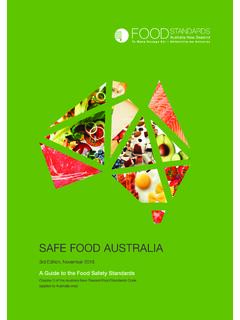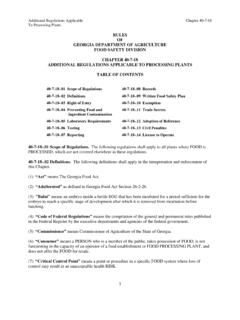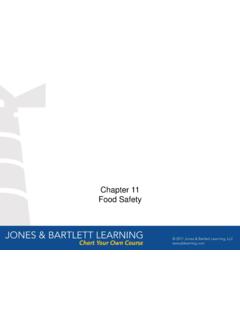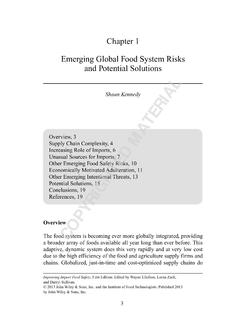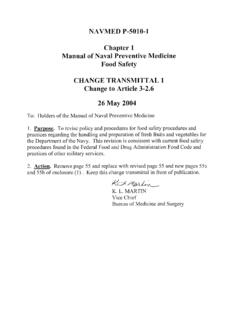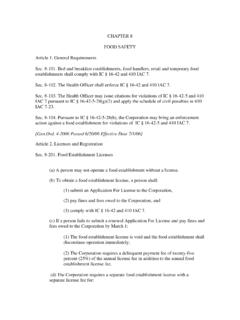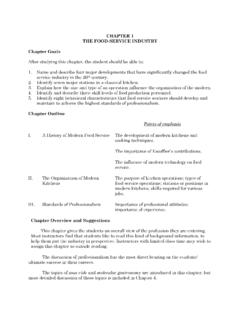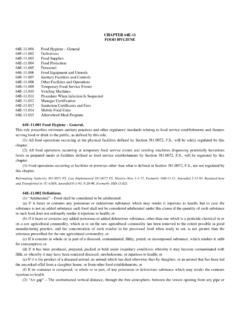Transcription of Chapter 6.4 Food Safety - JPR 1700.1
1 Chapter food Safety JPR Rev J, Change 3 (April 2012) Verify this is the correct version before you use it by checking the online version. This could be you .. A food employee didn t wash his hands after using the restroom and then prepared food for the salad bar and contaminated it. Six percent of the staff members became ill with acute dysentery with symptoms including chills, fever, abdominal cramps, and the abrupt onset of profuse watery or bloody diarrhea. Twenty-four individuals required hospitalization for intravenous hydration. The duration of illness for most persons ranged from 3 to 8 days. 1. Applicability of this Chapter You are required to follow this Chapter if you handle, store, or transfer food as a part of your job. 2. What this Chapter covers This Chapter describes the basic methods for you to use in preventing food -borne illness.
2 food served at JSC shall be clean, wholesome, free from germs or other toxins, and meet consumer expectations. It applies to transporting, storing, preparing, serving, vending, and inspecting food . This Chapter meets the provisions in the following: a. United States Department of Health and Human Services, food and Drug Administration (FDA), Center for food Safety and Applied Nutrition (CFSAN) publications titled food Code and Managing food Safety : A Manual for the Voluntary Use of HACCP [Hazard Analysis and Critical Control Point] Principles for Operators of food Service and Retail Establishments. b. Texas food Establishment Rules and other applicable regulations of the Texas Department of State Health Services (DSHS). c. food Ordinance of the City of Houston.
3 D. NPR , Chapter 3. Hazard Analysis Critical Control Points HACCP is a prevention-based food Safety management system that identifies and monitors specific food Safety hazards that can adversely affect the Safety of food products. All food prepared on site shall follow an HACCP or equivalent management system that includes and implements a process of self-inspection and continuous improvement. Part 6, Safety and health practices for certain hazardous tasks JPR Rev J, Change 3 (April 2012) Verify this is the correct version before you use it by checking the online version. 4. Certifications and employment conditions for food service To be certified to serve food , you shall: a. Have an initial medical examination within 30 days of employment and annual examinations thereafter (JSC Form 270).
4 See Chapter , Occupational Healthcare Program, of this handbook for more details. This applies to anyone involved in preparing or serving food and beverages. The JSC Clinic will give you the examination and a health certificate card (JSC Form 1169). The health certificate card shall be on file for inspection purposes. b. Never work with or around food or food preparation areas if you: 1. Are affected with a disease in a communicable form or are a carrier of a disease. 2. Are afflicted with boils. 3. Have infected wounds. 4. Have an acute respiratory infection. 5. Who to coordinate with for food service concerns This table tells you whom to contact for certain food service concerns: For .. Coordinate with the .. Scheduling and performing food service inspections or investigating food -related complaints Occupational Health Department (281) 483-6726 Scheduling medical examinations JSC Occupational Medicine Clinic (281) 483-4111 Ensuring compliance with requirements Exchange Operations Manager 6.
5 Other rules to follow or know about You shall follow these rules when handling food : a. Never remove or alter hold orders, notices, or tags placed on food by the health authorities. Re-labeling, repacking, reprocessing, altering, disposing of, or destroying this food is also forbidden without permission. You may put food that is on hold or has a tag on it from the health authorities in suitable storage for holding. b. Thoroughly wash your hands and arms with soap and warm water: 1. Before starting work. 2. During work hours, as often as necessary, to remove soil and contamination. 3. After using the toilet room. 4. After using tobacco products, applying cosmetics, and eating. Chapter , food Safety JPR Rev. J, Change 3 (April 2012) Verify this is the correct version before you use it by checking the online version.
6 7. How to protect food This section is not all-inclusive but highlights key food Safety techniques. To prevent food -borne illnesses, you shall: a. Protect all food being stored, prepared, displayed, served, sold, or transported between activities from contamination including dust, flies, rodents and other vermin, unclean utensils and work surfaces, unnecessary handling, coughs, sneezes, and flooding. b. Provide conveniently located refrigeration facilities, hot food storage and display facilities, and effective insulated facilities as needed to make sure all food is kept at required temperatures during storage, preparation, display, and service. Keep all cold food at temperatures below 40 F and keep all hot food at temperatures above 140 F. All dated food items should be within designated shelf life.
7 Remove outdated food items. c. Protect unwrapped food placed on display from contamination from customers and other sources. Use effective, easily cleaned, counter-protective devices, cabinets, display cases, containers, or other kinds of protective equipment. d. Design and arrange self-service openings in counter guards to protect food from contact by customers. e. Keep all garbage and rubbish that contains food waste in plastic bags that are in containers of durable metal or other approved materials that don t leak and don t absorb liquids. f. Dispose of all garbage and rubbish daily in a manner so as to prevent a nuisance. The Clinical services Branch may approve other frequencies for disposing of garbage or rubbish. g. Take effective control measures to keep rodents, flies, roaches, or other vermin from entering or breeding in any food service or preparation areas.
8 All buildings shall be effectively vermin-proofed, free of vermin, and kept in a vermin-proof and vermin-free condition. h. Prevent flies and other flying insects from entering through windows, door, skylights, intake openings, or exhaust openings. Use any effective methods such as the following: 1. Self-closing doors that open outwards 2. Closed windows 3. Screens 4. Controlled air currents i. Keep the entire food service facility and all areas used for food service or preparation neat, clean, and free of litter, refuse, and garbage. j. Keep all refrigerators used for food storage clean at all times. Part 6, Safety and health practices for certain hazardous tasks JPR Rev J, Change 3 (April 2012) Verify this is the correct version before you use it by checking the online version.
9 8. Vending machines All food offered for sale through vending machines shall be: a. Made, processed, and prepared in facilities that follow applicable federal, state, and local laws and regulations. b. Stored or packaged in clean, protective containers and be handled, transported, and vended in a sanitary manner. 9. Bottled Water Dispensers Use only bottled water approved by the Clinical services Branch in bottled water dispensers. Never refill empty bottles yourself. Only the processor is allowed to refill bottles. All organizations using bottled water shall ensure that: a. No bottles of water or bottled water dispensers are located or stored in areas where general hazards or contamination of any kind poses a threat to users under normal operations.
10 B. Contractors and subcontractors furnishing bottled water provide routine chemical and microbiological laboratory analysis reports for bottled water delivered to the Center. c. Bottled water dispensers are maintained in a sanitary condition. d. All dispensers have equipment numbers. e. There is prompt recall of the suspect bottled water or other appropriate action when notified of contamination. 10. Protective clothing required for food service You shall wear: a. Gloves when: 1. You do multiple tasks such as handling money and preparing sandwiches. 2. Frequent hand washing is not feasible. b. Reasonably clean outer garments if you handle food or food -contact surfaces, or wash dishes. c. A hair restraint if you prepare or serve food . The restraint shall completely cover your hair to keep hair from food and food -contact surfaces.

